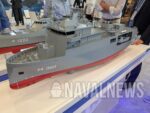South Korean defense giant Hanwha Aerospace has revealed its next-generation infantry fighting vehicle (IFV), the K-NIFV (Korean Next-generation Infantry Fighting Vehicle), designed to meet evolving threats on modern battlefields. Equipped with artificial intelligence-enhanced drone detection and defeat capabilities, an active protection system (APS), and modular armor options, the K-NIFV represents a significant leap beyond existing platforms like the Redback and K21.
Next-Generation Design Philosophy
The K-NIFV is being developed as part of South Korea’s long-term initiative to replace its aging fleet of K200 series armored vehicles and complement the more heavily armed Redback IFVs. While still in prototype form as of late 2025, Hanwha has showcased a full-scale demonstrator at several defense exhibitions including ADEX 2025 in Seoul.
The vehicle integrates lessons learned from recent conflicts such as Ukraine—where loitering munitions and small drones have proven highly disruptive—and aims to provide enhanced crew survivability through layered defenses. The design emphasizes modularity for future upgrades in sensors, weapons systems, and protection suites.
AI-Driven Counter-Drone Capabilities
One of the most distinctive features of the K-NIFV is its embedded artificial intelligence suite dedicated to counter-unmanned aerial system (C-UAS) operations. According to Hanwha representatives at ADEX 2025, the vehicle uses AI algorithms fused with EO/IR sensors and radar to autonomously detect low-flying drones—including FPVs—and cue soft-kill or hard-kill responses.
This includes integration with a roof-mounted remote weapon station capable of engaging aerial targets using a 7.62 mm machine gun or programmable airburst munitions from its main armament. Additionally, electronic warfare modules are reportedly under development for non-kinetic drone neutralization via GNSS jamming or RF disruption.
The AI engine also supports threat prioritization and sensor fusion across multiple domains—land and air—reducing crew workload while improving reaction times against swarming UAS threats.
Armament and Protection Suite
The primary armament on the current prototype is a 30mm autocannon mounted on an unmanned turret similar in architecture to that used on Hanwha’s AS21 Redback. The turret also houses a coaxial machine gun and optionally integrates anti-tank guided missiles (ATGMs). The fire control system is stabilized for firing on the move and includes thermal imaging sights for day/night operations.
For survivability against kinetic threats such as RPGs or ATGMs, the K-NIFV features an indigenous Active Protection System (APS) developed by Hanwha Systems. While details remain limited due to classification concerns, it reportedly uses radar-based threat detection coupled with hard-kill interceptors similar in concept to Israel’s Trophy or Russia’s Afghanit systems.
The base armor provides STANAG Level 4 ballistic protection against 14.5 mm AP rounds and artillery shell splinters. Modular add-on armor packages can increase this level based on mission requirements. Mine blast resistance is achieved through a V-shaped hull design tested against STANAG Level IIIB standards.
Crew-Centric Digital Battlefield Integration
The vehicle accommodates three crew members—commander, driver, gunner—and up to eight dismounts in the rear compartment. All crew stations are networked via a digital backbone enabling real-time data sharing from onboard sensors as well as external C4ISR networks.
- Battlefield Management System (BMS) integration allows coordination with other armored units via Link-K tactical datalink protocols.
- A panoramic commander’s sight provides full situational awareness through color EO/IR feeds fused into helmet-mounted displays or touchscreen consoles.
- Driver-assist functions include obstacle detection using front-facing cameras combined with LIDAR inputs for semi-autonomous navigation in complex terrain environments.
This digital architecture also supports future manned-unmanned teaming (MUM-T) concepts where the IFV could coordinate operations with UGVs or UAVs deployed ahead of formation lines.
Strategic Context: Positioning Beyond Redback
The introduction of the K-NIFV suggests that South Korea is aiming not only to modernize its own mechanized forces but also position itself competitively in global armored vehicle markets dominated by platforms like BAE’s CV90 MkIV or Rheinmetall’s Lynx KF41. While Hanwha already fields the AS21 Redback—a contender in Australia’s LAND 400 Phase 3 program—the K-NIFV appears optimized for domestic needs emphasizing cost-effective scalability over expeditionary deployment profiles.
According to South Korean Ministry of National Defense planning documents reviewed by local media outlets such as Yonhap News Agency and Defense Times Korea:
- K-NIFV production may begin post-2028 following full operational testing by ROK Army mechanized brigades starting mid-2026;
- A total acquisition target exceeding 500 units has been floated depending on budget allocations;
- The platform may serve as a testbed for integrating indigenous loitering munitions launchers or robotic wingmen over time;
Outlook: From Prototype to Operational Platform
The path from demonstrator to fielded system remains contingent on rigorous validation trials under realistic combat conditions—including live-fire APS tests against top-attack munitions and swarm drone simulations. If successful, it could represent one of Asia’s most advanced IFVs tailored for multidomain warfare environments increasingly shaped by autonomous threats.
Hanwha continues parallel development efforts across its land systems portfolio including upgrades to existing K21 vehicles using select subsystems derived from the K-NIFV program—suggesting a broader modernization roadmap aligned with ROK Army doctrinal shifts toward networked maneuver warfare by 2030.










